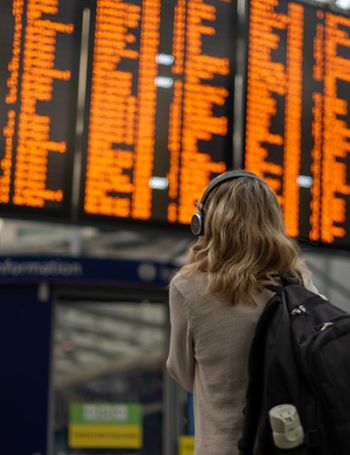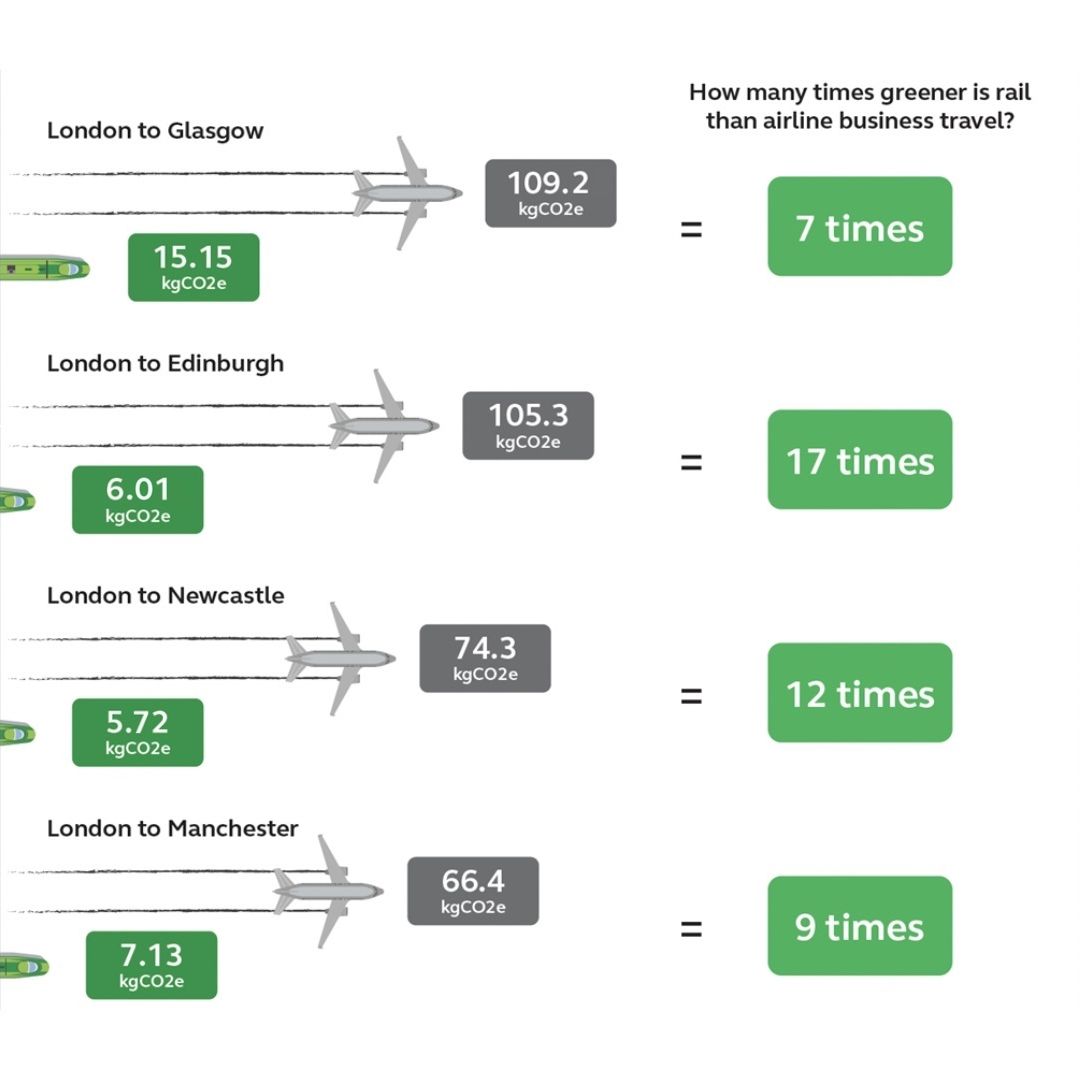Clearing the air
August 2024 update
A comparison of rail and domestic air routes in Britain
Better by train
We’re often told that flying domestically is faster, cheaper, and more convenient. This myth is amplified by quick comparisons that typically ignore the length of time security checks take at airports as well as ignoring add-on costs for luggage and seat selection.
Many don’t take into account of the time it takes to get to and from the airport and forget that railway stations are in central convenient locations, while airports sit on the outskirts of our cities.
There is also the environmental impact of these choices too. For example, travelling by train for business between Edinburgh and London is 17 times greener by rail than by plane, according to new Green Travel Pledge data.
Travelling long-distances across Britain presents a choice for customers between rail and domestic air travel.

For too long, the narrative has been that flying domestically is cheaper and faster. However, when you do a true cost comparison, rail travel is considerably cheaper.
Rail travel offers a more affordable, sustainable, and convenient way to travel. Our research highlights the many advantages that rail travel offers to our customers when travelling within Britain.
Routes compared
We have picked six domestic routes that offer both trains and flights to provide a fair comparison of costs, carbon emissions and availability of services.
Key takeaways
CHEAPER: Travelling by rail can be up to 70% cheaper on similar routes than flying, when accounting for the additional cost of baggage and seat selection.
MORE SUSTAINABLE: Rail is up to 17 times greener when travelling for business across Britain compared to flying.
FASTER: Travelling by plane takes longer than by train city-to-city for four out of the six domestic travel routes we looked at.
MORE FLEXIBLE: Overall, trains are more frequent than planes, especially for routes like London - Newcastle and Manchester - London.
The cost of a city-to-city journey is cheaper by rail
Travelling by rail can be up to 70% cheaper on similar routes than flying, when accounting for the additional cost of baggage and seat selection.
-
London – GlasgowRail £171 Plane £248Rail £171 FREE
Plane £196 £52 -
London – EdinburghRail £156 Plane £260Rail £156 FREE
Plane £198 £62 -
Manchester – LondonRail £91 Plane £341Rail £91 FREE
Plane £300 £41 -
Aberdeen – ManchesterRail £224 Plane £234Rail £224 FREE
Plane £222 £12 -
London – NewcastleRail £145 Plane £384Rail £145 FREE
Plane £299 £85 -
Edinburgh – ExeterRail £220 Plane £297Rail £220 FREE
Plane £285 £12






- Average costs of a fare between selected routes for a one-way trip departing on August 5 and a one-way trip returning on August 9 (total combined cost of both one-way trips).
- Prices taken between 8 and 10 July directly from rail and flight operators.
- We acknowledge the advisory input from the Birmingham Centre for Railway Research and Education (BCRRE), University of Birmingham, which assisted with the development of the cost calculation methodology in this report. The insights presented herein are based on the RDG's own analysis.
- Refer to the attached appendix to find out more about our cost analysis.
Taking the train is even cheaper when using a Railcard
With a Railcard, you'll pay even less than the prices listed above, saving 1⁄3 on train travel for each route:
- London – Glasgow: £171 £113
- London – Edinburgh: £156 £103
- Manchester – London: £91 £60
- Aberdeen – Manchester: £224 £148
- London – Newcastle: £145 £96
- Edinburgh - Exeter: £220 £145
Booking ahead by rail delivers better value for customers
We have analysed the cost of taking similar trips across Britain in August 2024, noting that fares can vary depending on how far in advance the booking is made, the date chosen and the time of travel.
Whilst it is sometimes possible to purchase a cheap single airline fare between domestic British airports, the presentation of this as the total cost of travel fails to give customers the other associated costs including transfers, baggage, and seat selection.
Additional costs of airport transfers, seat selection and baggage make rail the right choice
Our report shows that the base airfare for domestic flights is frequently more expensive than train tickets. When you factor in the additional costs associated with flying, such as seat selection, baggage fees, and airport transfers, rail travel often emerges as the more economical choice.


Top tips to save on a train ticket in Britain.
- Book in advance wherever possible – most cheap tickets are released roughly 12 weeks prior to travel.
- Get a Railcard to save around 1/3 off most rail journeys at www.railcard.co.uk
- Claim a refund from the train operator if your journey is delayed or cancelled via Delay Repay.
Airport to city centre transfer costs
Airport transfers are a significant cost for customers (and not included in our cost analysis in the section above); these additional costs are not always considered at the point of purchase. In contrast, rail delivers people into the heart of towns and cities across Britain, avoiding the added time and expense of airport transfers.
Average return fare for a minicab between the airport and city centre, with cost sources hyperlinked above.
These findings corroborate the research undertaken by Campaign for Better Transport’s report, ‘Plane speaking: moving journeys from air to rail’, which found that of the top 20 UK routes, half were found to be cheaper by rail.
More sustainable by rail
Rail is up to 17 times greener when travelling for business across Britain compared to flying.
Air travel is now the fastest-growing contributor to global warming (contributing between 4% - 9% of total emission output). Avoiding a flight when there are easy alternatives is often the biggest single thing that any individual can do to cut their carbon footprint and limit their impact on the environment. Rail is the cleanest public transport option available, contributing only 1.5% of the UK’s total transport emissions.
In 2019, 3.4 million people travelled between London and Edinburgh by air, making it the 2nd busiest air corridor in Europe producing 244,000 tonnes of CO2 per year.
Rail is one of the most environmentally friendly ways of transporting large numbers of people for long distances, at speed. Rail is intrinsically a sustainable form of transport as new carbon calculations, from Rail Delivery Group, demonstrate that travelling by rail between Edinburgh and London is 17 times greener than the equivalent flight.
We’ve used new Green Travel Pledge carbon data to compare a business trip by plane and by train.

Comparative plane and train carbon emissions data is currently unavailable for Edinburgh - Exeter and Aberdeen - Manchester routes.
Overall city-to-city domestic travel time is quicker by rail
Overall city-to-city domestic travel time is quicker by rail
-
London – GlasgowTRAIN QUICKER BY 15 MINSFlight time1 hr 15 MinsTotal city-to-city travel time for air4 hrs 45 MinsRail travel time4 hrs 30 Mins
-
London – EdinburghTRAIN QUICKER BY 20 MINSFlight time1 hr 10 MinsTotal city-to-city travel time for air4 hrs 40 MinsRail travel time4 hrs 20 Mins
-
London – ManchesterTRAIN QUICKER BY 2 HRS 24 MINSFlight time1 hrTotal city-to-city travel time for air4 hrs 30 MinsRail travel time2 hrs 6 Mins
-
Manchester – AberdeenPLANE QUICKER BY 56 MINSFlight time1 hr 10 MinsTotal city-to-city travel time for air4 hrs 40 MinsRail travel time5 hrs 36 Mins
-
London – NewcastleTRAIN QUICKER BY 2 HRS 3 MINSFlight time1 hr 10 MinsTotal city-to-city travel time for air4 hrs 40 MinsRail travel time2 hrs 37 Mins
-
Exeter – EdinburghPLANE QUICKER BY 2 HOURS 42 MINSFlight time1 hr 25 MinsTotal city-to-city travel time for air4 hrs 55 MinsRail travel time7 hrs 37 Mins






-
London – GlasgowTRAIN QUICKER BY 15 MINSFlight time 1 hr 15 Mins
Total city-to-city travel time for air
4 hrs 45 Mins
Rail travel time 4 hrs 30 Mins -
London – EdinburghTRAIN QUICKER BY 20 MINSFlight time 1 hr 10 Mins
Total city-to-city travel time for air
4 hrs 40 Mins
Rail travel time 4 hrs 20 Mins -
Manchester – LondonTRAIN QUICKER BY 2 HRS 24 MINSFlight time 1 hr
Total city-to-city travel time for air
4 hrs 30 Mins
Rail travel time 2 hrs 6 Mins -
Aberdeen – ManchesterPLANE QUICKER BY 56 MINSFlight time 1 hr 10 Mins
Total city-to-city travel time for air
4 hrs 40 Mins
Rail travel time 5 hrs 36 Mins -
London – NewcastleTRAIN QUICKER BY 2 HRS 3 MINSFlight time 1 hr 10 Mins
Total city-to-city travel time for air
4 hrs 40 Mins
Rail travel time 2 hrs 37 Mins -
Edinburgh – ExeterPLANE QUICKER BY 2 HOURS 42 MINSFlight time 1 hr 25 Mins
Total city-to-city travel time for air
4 hrs 55 Mins
Rail travel time 7 hrs 37 Mins






Cost is an important factor for customers, but for many travel time is of equal importance. At first glance, flying may seem to be the fastest way to get between two cities, but when looking at the total time taken from city centre to city centre, rail delivers an equivalent or quicker option. Typically journeys by air involve additional trips to get to the airport from the city centre. You also need to take into account the recommended time to be at the airport before the scheduled departure time, as well as the 30 minutes to disembark, and the onward journey into the city centre. In total, this can add three and a half hours onto the journey. City centre to city centre flying takes longer on four of the six routes reviewed.
More flexible
Overall, trains are more frequent than planes, especially for routes like London – Newcastle and Manchester – London.
Rail offers a more frequent service and can provide seamless connections to more destinations. Rail networks reach destinations that may be inaccessible by air, offering travellers the opportunity to explore remote villages, historic towns, and charming countryside retreats, that are often missed when travelling by air.

Choose rail
This report demonstrates that travelling by rail is cheaper, more sustainable, and often quicker, compared to air, when travelling domestically. Rail travel is simpler, with fewer processes and more alternative routes available if things go wrong.
By choosing to take the train, you are helping the planet while also saving yourself from hidden costs for baggage and airport transfers. We hope the facts and figures contained in this report help to clear the air and show why taking the train is the best way to travel across Britain.